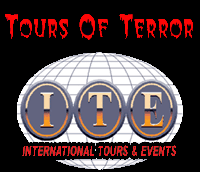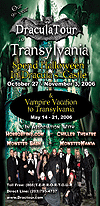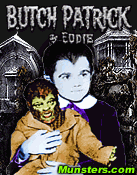
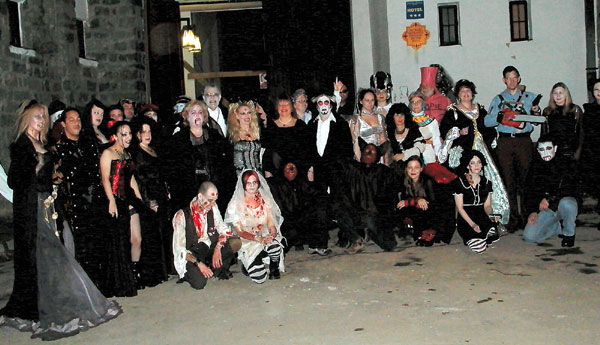
Photo credits: Lynn, Jeffrey, Michelle, Nikki, Grayson, Holly & Robert, Melissa & Joe,
Rita & Tony, Kajun & Kristin, Shannon (hope we didn't forget anyone... if we did, let us know)
Our Romanian tour guide, Radu, cheerfully met all of us, and herded us towards the awaiting Atlantic blue luxury Mercedes Benz touring bus. Others were joining our group, winners of Universal's 'Van Helsing' Sweepstakes (Laurie, Shannon, Grayson, Robin and Candace) and those already in Europe. A small van was provided for the winners to travel in.
Bucharest is big, crowded and jammed with vehicles. Traffic crawled along, giving Radu a chance to explain much of the Romanian customs, including the fact that the country is both 'Paradise and Hell.' He explained that we would not be going to the average tourist spots and told about how Romania had joined the European Union and that the Euro would be coming in 2007. Meanwhile, American dollars go very far in Romania.
Hotel Lebada was our first stop for our First Fright Night. It is a beautiful remote castle that had also been used as a prison, then a convent, once again as a prison and more recently converted into a luxury hotel. It sits in the middle of a lake and has beautiful quiet grounds. It's a perfect spot to recuperate from jet lag and get that much-needed bath. We spent the evening as a group at a welcome/orientation dinner held in the restaurant, where we met the rest of our group. Our 'Drac Pack' consisted of physicians, teachers, students, poets, veterinarians, animal groomers, real estate agents, police & correctional officers, hairdressers, tattoo artists, piercing artists, retired professors. We had singles, families and some couples who were either getting married, just got married, or were renewing their vows on this trip. Not everyone was one of the 'believers,' as several spouses admitted to being just along for the ride. One of the travelers, Bill, was a cousin of James Warren, founder and publisher of 'Famous Monsters of Filmland' magazine. Another, Tony, wound up being the star of a television game show. There was good pedigree in the room!
Friday morning we started out early to exchange money and leave for Snagov and Bran. Bucharest was enchantingly foggy and you could almost feel a drizzle in the air, setting up the atmosphere for our day's
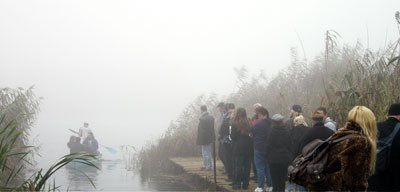 sightseeing. We arrived at Snagov Monastery with the area shrouded in an eerie fog. From the bank of Snagov Lake you could not see anything. Glad this wasn't Crystal Lake! In groups of five we climbed into small wooden boats to be ferried across the lake. Not until we docked could you see anything of the structure standing on that island.
sightseeing. We arrived at Snagov Monastery with the area shrouded in an eerie fog. From the bank of Snagov Lake you could not see anything. Glad this wasn't Crystal Lake! In groups of five we climbed into small wooden boats to be ferried across the lake. Not until we docked could you see anything of the structure standing on that island.In 1456 Vlad Tepes (the Impaler) built fortifications around the monastery. He also built a bridge from the island to the mainland, a bell tower, a new church, an escape tunnel, and a prison and torture chamber. The body of Vlad Tepes was reputedly buried below the dome, just in front of the church's wooden icons. However, when the grave was opened in 1931 it was reported to hold bones of a horse. Radu explained that 'strigoi' (the Romanian form of vampire) were trapped souls that were neither alive nor dead, and that they could not die and cross over until they sucked a soul from a living person. Having accomplished this, they turn into a horse and die. It is at this point they are allowed to enter into the afterworld. This would explain the horse bones they found(?). A headless torso was also found, evidence that the unfortunate owner may have been killed by the Turks, as decapitation was a favorite Turkish execution method. Today, the humble grave inside the church is marked by a simple portrait of Vlad. The church continues to undergo restoration in an effort to preserve some of its wonderful wall paintings and rich history.
We left Snagov Lake and traveled into the country beyond the forests, towards Bran. As we moved from Wallachia into Transylvania the sun came out and we enjoyed the picturesque scenery and watched videos. We traveled through mountains and rolling plains. Radu pointed out where 'Ben Hur,' 'Highlander I and II, and 'Cold Mountain' had been filmed.
Bran is nestled in a mountain pass, and during the 15th and 16th centuries was an important frontier town on the main road leading from Transylvania into Wallachia. We reached the castle in mid-afternoon. Bran Castle, commonly known as 'Dracula's Castle,' was not built by Vlad Tepes, the 15th
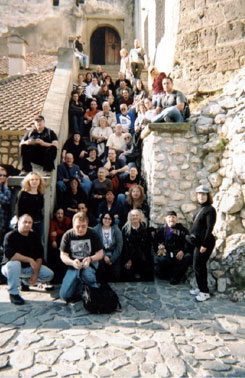 century Wallachian prince upon whom the novelist Bram Stoker is supposed to have based his vampire, Count Dracula. The castle, perched atop a 60 m peak in the center of Bran village, was in fact built by Saxons from Brasov in 1382 to defend the Bran pass against Turks. The closest the place comes to anything remotely connected with Dracula is that Vlad might have sought refuge here for a few nights on his flight from the Turks in 1462, following their attack on Poienari fortress in the Arges Valley. Others believe he may have been imprisoned here for a short time. From 1920 the castle was inhabited by Queen Marie and it remained a summer royal residence until the forced abdication of King Michael in 1947.
century Wallachian prince upon whom the novelist Bram Stoker is supposed to have based his vampire, Count Dracula. The castle, perched atop a 60 m peak in the center of Bran village, was in fact built by Saxons from Brasov in 1382 to defend the Bran pass against Turks. The closest the place comes to anything remotely connected with Dracula is that Vlad might have sought refuge here for a few nights on his flight from the Turks in 1462, following their attack on Poienari fortress in the Arges Valley. Others believe he may have been imprisoned here for a short time. From 1920 the castle was inhabited by Queen Marie and it remained a summer royal residence until the forced abdication of King Michael in 1947.The castle is a winding maze of narrow passageways and stairways. The rooms have been decorated much as they would have been in old days, with original pieces of ornate, carved heavy furniture. From the top of the tower the view is spectacular. Radu took us through, giving us great historical information. It felt like you had stepped back in time. You could even see where parts had been used in the Coppola film 'Bram Stoker's Dracula.'
Outside the castle stood market places with stalls of souvenirs. You could buy all sorts of postcards, t-shirts and trinkets of every imaginable kind bearing the Vlad's face or the name Dracula. One could spend hours walking and shopping. We shopped
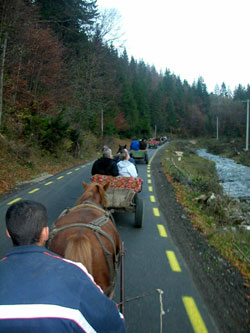 vigorously before moving on up the mountain to where we would partake in a traditional Romanian meal.
vigorously before moving on up the mountain to where we would partake in a traditional Romanian meal.Our buses stopped at the bottom of a road and we proceeded on foot to the horse-drawn wooden carriages. We were carried up the mountain along a winding road in the crisp evening air. A babbling brook ran alongside of us and we enjoyed the chance to soak in the atmosphere.
I Upon reaching Cralasa Municcor we were greeted with heated pear brandy as we walked into the chalet style restaurant. We dined in the loft that ran the perimeter of the restaurant. Music filled the air as everyone feasted on a three-course meal. Afterwards some danced while others (Erin, Jeffrey & David) competed in a spirited drinking match.
We reached our second hotel, the Aro Palace, which faces the town square in Brasov. Tired and plied with alcohol, everyone retreated to the quiet of their rooms with only the sounds of electric streetcars in the background. Others, however, decided that the night was still young and went to a great bar recommended by Charles and Radu, just around the corner. It was a great opportunity to spend time getting to know each other, as
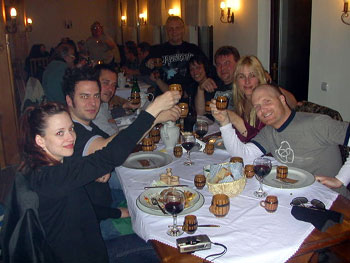 well as get a firm foothold on the title 'most intoxicating, and INTOXICATED, group ever'! After closing down the bar, we couldn't resist having a couple more rounds at a small beer stand right across from the hotel. We decided to take the advice that was written in English on the side of the enormous beer can and, 'Live life to the full!'
well as get a firm foothold on the title 'most intoxicating, and INTOXICATED, group ever'! After closing down the bar, we couldn't resist having a couple more rounds at a small beer stand right across from the hotel. We decided to take the advice that was written in English on the side of the enormous beer can and, 'Live life to the full!'The next morning we went on a walking tour of Brasov. The city's position at the foot of the mountains and at the crossing of several old communication roads connecting the lower Danube area to the Carpathian basin, was decisive for the accomplishment of its exceptional role as a commercial, cultural and handicraft center. Brasov was the city where wines were traded for goods from the north. Wine cellars still meander under the city square.
The Black Church still dominates the medieval city center. It is one of the most important and certainly the most imposing monuments created by the Transylvanian Saxons during their 850 years of history. The name of 'The Black Church' was given its name after the catastrophic fire in 1689, when the entire city practically burnt down. The flames and the smoke blackened its walls, but the sumptuousness and the grandeur of the church could not be shattered. It is the largest gothic church between Vienna and Constantinople, and was built between 1383 and 1477. The guilds maintained the fortifications about the city to fend off the Mongols. Inside the church, each guild had its assigned seating. Rich tapestries hang from the balconies, gifts from when the city opened a colony in Mosul. They sent many gifts of Persian rugs, which you see displayed today. There is a pipe organ that came from Prague, which uses water pressure in the pipes to provide its rich sound.
Cobblestones line the pedestrian streets and there is a shopping area just off the town square. In the town square there is a fountain and a clock tower, which served as the town hall in its day. Many of us enjoyed wandering the shops. We left at noon headed for Sighisoara.
Sighisoara is a 13th century established citadel, which is still alive and mostly unchanged from the Middle Ages. It underwent development again in the 15th and 17th centuries and the newer part is lower down. 'Casa Dracula,' now a restaurant, is the house where the city guardian lived. In 1431-1435 the future ruling Prince of Wallachia, Vlad, came here to live. Vlad was from a family of good warriors. Many warriors came here to train as mercenaries. The order of the dragon was awarded for skills and Vlad added the nickname 'Dracul.' He resided for 5 years in this house as an employee of the city defending it, and he had 2 sons. Vlad Dracula was born in 1431 and his brother Radu in 1432 (A boy born to the family of Vlad Dracul added an 'a' to the name; Vlad Dracula or 'Son of Vlad Dracul'). Dracul is also a nickname for dragon or devil, so Romanians pronounce it as Draculia and Coppola used exact Romanian accents in his film 'Bram Stoker's Dracula.'
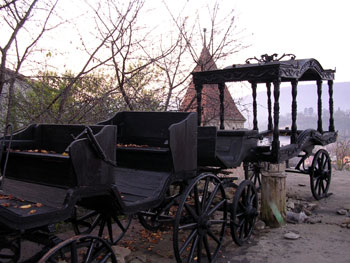 A massive clock tower stands on the edge of the walled city with its history museum, torture chamber and collection of medieval weapons. A statue of Vlad Tepes hides itself behind the Church of the Dominican Monastery. In the square, witches were tried and merchants sold their wares. We were treated to a dramatic recreation of the Romanian Witch Trial.
A massive clock tower stands on the edge of the walled city with its history museum, torture chamber and collection of medieval weapons. A statue of Vlad Tepes hides itself behind the Church of the Dominican Monastery. In the square, witches were tried and merchants sold their wares. We were treated to a dramatic recreation of the Romanian Witch Trial.Shops line the streets of the citadel and many small restaurants dot the lower area. Just before dusk we walked left from the square to an ancient cemetery with a fully-covered wooden stairway and its 172 steps. It is said to be haunted and that if you linger more than 10 seconds your soul will be stolen. This stairway has tunneled its way up the hill since 1642, to the Gothic Church on the Hill that was built in 1345. We wandered the graveyard stopping for photos before heading back down into reality and the awaiting bus.
Into the dark night we rode, watching movies as we made our way to Bistrita, a small and unassuming market town is at the heart of 'Dracula land.' The dramatic countryside west and east of town has more bite than anything you find at Bran. It was here that Dracula author Bram Stoker made his leading character, Jonathan Harker, stay the night on the eve of St. George's Day before continuing his journey east to Dracula's castle.
The road winds and cuts back and forth as we climb into the mountains. Our drivers kept on at a steady speed, never slowing down. Inside we jostled a slight bit, reminding one of Harker's wild ride in the dark, wonderful atmosphere.
We pulled into the Hotel Coroana De Aur, where Jonathan Harker stayed in the novel. There was no such
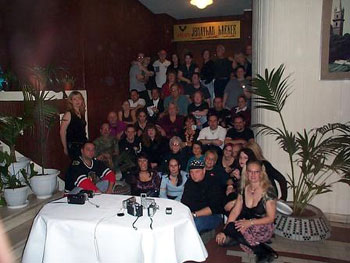 hotel at the time Dracula was published, but one was later built to make history right and keep the tourist buses coming. Having checked into our rooms, we prepared for the special meal to begin in the Jonathan Harker Salon.
hotel at the time Dracula was published, but one was later built to make history right and keep the tourist buses coming. Having checked into our rooms, we prepared for the special meal to begin in the Jonathan Harker Salon.Group pictures were taken as we awaited the opening of the restaurant, which had been reserved exclusively for our group this evening. The doors opened into blackness. We were greeted with brandy as someone pointed a pitchfork at our neck and a hand grabbed our legs. The inside of the room was decorated blood red, with candles the only illumination. Tables had been set up in a horseshoe shape and skulls with antlers and fangs decorated the walls. A woman visited every guest and placed a garlic clove necklace around our necks; many took their off... perhaps hoping to be bitten! Dinner started with toasts made by one and all for Kristin and Kajun, who were to be married the next day. We toasted the tour guides, and our bus drivers who kept us on schedule despite the winding roads and traffic. We dined on kabobs and after dessert the games began, with celebrations going on into the wee hours of the morning.
The next day was Halloween! We had breakfast in the room we had partied in the night before. However, now you could see the tile floor, the usual buffet equipment and normal tables with bright lights. Reality had once more returned. We boarded our coach around noon for the short trip up the Borgo Pass, an area Bram Stoker wrote floridly about, but never visited himself. The snaky, narrow main road winds its way slowly upwards, past subdued villages and farms, past both steep and gentle hills, springs, creeks, and sheep grazing in the conifer-sweetened air. The communists paved over the original horse trails, necessary for the horse drawn carts carrying their wares to the marketplace. All along our journey we saw many of these carts carrying produce or hay. Today, we noticed the carts carried families to roadside picnics.
At the top we reached Piatra Fantanele and the Hotel Castle Dracula. The castle-hotel, better known as Dracula's Castle, towers 1116m high on the spot where Stoker sited his fictitious Dracula's castle.
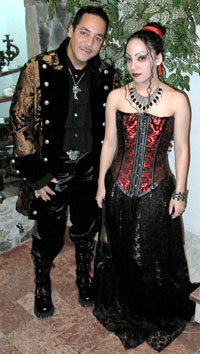 The views of the pass are great from here. The architect who designed the building had studied Dracula movies, and the rooms are fitted out thematically. It boasts being the only castle hotel with a tower, an inside court from Romania, with a little cemetery near it. Not far away is a ski lift and on the edge of the front entrance sits a marketplace open for our shopping.
The views of the pass are great from here. The architect who designed the building had studied Dracula movies, and the rooms are fitted out thematically. It boasts being the only castle hotel with a tower, an inside court from Romania, with a little cemetery near it. Not far away is a ski lift and on the edge of the front entrance sits a marketplace open for our shopping.When the hotel was finished, twenty-one members of the Dracula Society from London carried bricks by hand. They left a document with their signatures in an empty scotch bottle. There is a sign on the wall, which indicates there the document is hidden, but this secret is known only by the master of the Dracula Castle.
The afternoon was ours. Everyone took advantage of a chance to shop. Some actually rode the ski lift to the top. The scenery was spectacular, but there was no snow. Our whole trip came during a very mild period in the weather and the locals were still awaiting winter. Charles and Radu commented that it was the warmest it's ever been at this time of year. Many used their free time to prepare for the Masquerade Ball in hopes of winning the costume contest.
At 7 pm we gathered in the reception area of the hotel for photos of our costumes. There were a large assortment of vampires, a few zombies, a pirate, bats, mad scientists, zombie hunters and all manner of spooky creatures.
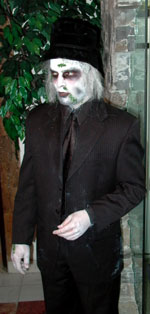 Once everyone arrived, group shots were taken. Romanian National Television showed up to film the event. We took another group picture outside in front of the
Once everyone arrived, group shots were taken. Romanian National Television showed up to film the event. We took another group picture outside in front of the
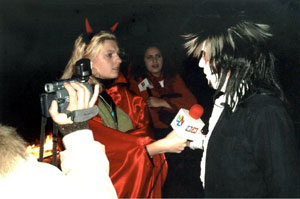 castle, and this was filmed by another television crew and other Romanians with cameras.
castle, and this was filmed by another television crew and other Romanians with cameras. Radu explained that Halloween was not celebrated as we do in America. Instead they celebrate All Souls Day on November 1st and remember their dead. The only guests at the castle on October 31st were foreigners. A few tourists from England were also there but they had their own party going on upstairs in the main restaurant, which was, by their own admission, not nearly as fun as ours. They begged to join our group!
We were escorted to the downstairs basement area where our party awaited. Tables were decked out with fancy tablecloths, a sharp contrast to the skeleton candies scattered about and the cobwebs
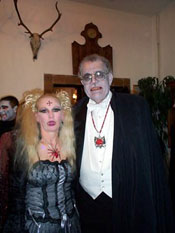 with spiders hanging from the walls. The arches in the stone and the lights had been dimmed, candles were lit, and a DJ station stood in one corner.
with spiders hanging from the walls. The arches in the stone and the lights had been dimmed, candles were lit, and a DJ station stood in one corner.Before we were seated, there was one more treat. Romanian musicians appeared outside our doors and we followed them down steps into the night air. They lead us around the side of the hotel for a huge bonfire. As we made the journey, some of the local Romanians had come out with their children to see us in our costumes.
Again we were
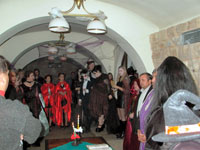 handed brandy as we walked towards the fire, and large wooden stakes with slabs of meat for hors d'ouevres. It burned high into the night sky.
handed brandy as we walked towards the fire, and large wooden stakes with slabs of meat for hors d'ouevres. It burned high into the night sky.Returning inside, we stood witness to the wedding of Kristin & Kajun, presided over by a Romanian Priest. Charles escorted & gave away the bride, and Radu was best man. Following this was the renewal of wedding vows by couples
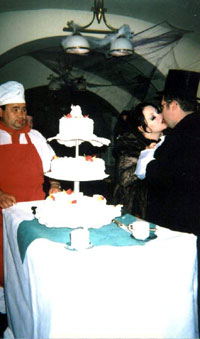 celebrating their wedding anniversaries.
celebrating their wedding anniversaries. Then came the dancing. For hours everyone danced the night away, drinking vampire wine and partying. Charles out did himself drawing out the people and involving them in the many different dances. Even Radu and the bus drivers joined in our celebration.
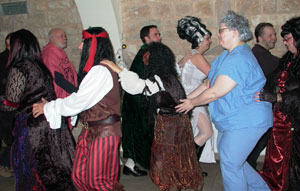 The multi-course meal was followed by more dancing and a trip to the castle's real basement. In small groups Charles led us down a narrow passageway by candlelight into a dark room. We are sworn to secrecy as to what is in this dungeon of dread.
The multi-course meal was followed by more dancing and a trip to the castle's real basement. In small groups Charles led us down a narrow passageway by candlelight into a dark room. We are sworn to secrecy as to what is in this dungeon of dread.A flaming wedding cake was wheeled out. It was a sweet cake decorated fittingly with a skeleton couple. Instead of singing 'The Bride Cuts The Cake,' everyone sang 'The Bride Cuts The Groom.' Then Kristin tossed her flowers to the single women (caught by the enchanting Nadia), followed by the garter tossed to the single men. Dancing and celebrating continued until we found our way back to our rooms (or someone else's).
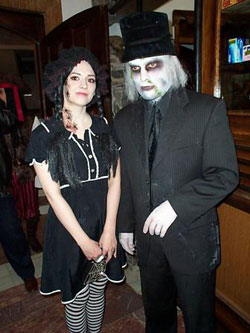 The next day was All Souls Day. We boarded the
The next day was All Souls Day. We boarded the
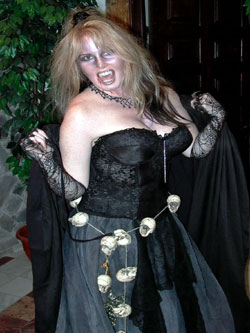 bus, and Charles announced the winners of the costume contest. Sexiest Costume went to Grayson (he dressed up as a fashion diva) and he received a prize plus $50.00.
bus, and Charles announced the winners of the costume contest. Sexiest Costume went to Grayson (he dressed up as a fashion diva) and he received a prize plus $50.00. Funniest Costume went to Gene, who dressed up as a giant whoopee cushion; he received a prize and $50.00. Most Creative and Best Overall was a tie with the prizes going to Matt (the Zombie) and Bob (dressed as Ash from the 'Evil Dead' films). They each received $200.00 prize value.
Contest Winners
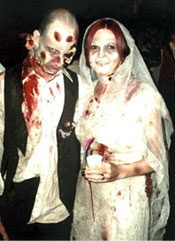
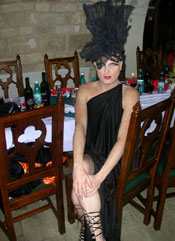
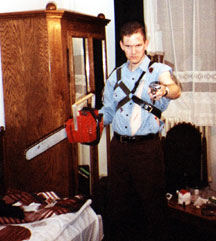
Our travels took us through Targus Mures, which was traditionally a Hungarian stronghold. It developed as a leading garrison town and later as an important cultural and academic center. Today signs are hung in both Hungarian and Romanian. Only in Transylvania will you see the Orthodox bringing flowers and food to remember their dead. Tonight they will bring candles to light up the graves, as today they pay a visit to dead family members.
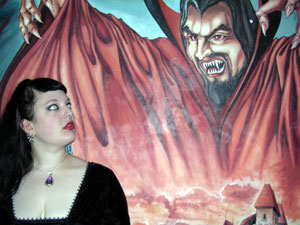 We paused on our journey south to eat at the Rex Restaurant in Sighisoara. It was a nice sit-down meal in a good restaurant, and so cheap by American standards.
We paused on our journey south to eat at the Rex Restaurant in Sighisoara. It was a nice sit-down meal in a good restaurant, and so cheap by American standards. Radu had the coaches stop at a cemetery so we could witness the beauty of All Souls Day. We walked up a street to a cemetery that sparkled in the dark of night. All the graves twinkled from the tea lights placed by loved ones. Every grave had a candle and flowers. It was a beautiful sight to behold.
Reaching Sibiu and the Imparatul Romanilor Hotel in the early evening, Radu gave directions for those wishing to go out to eat or find a cyber café. There was even a park nearby packed with bats. That was a must-visit for our group!
We woke early the next day and shopped along the streets near the hotel. We then formed up for a walking tour of Sibiu. The city was founded on the site of the former Roman village of Cibinium, and has always been one of the leading cities of Transylvania. During the peak of Saxon influence, Sibiu had 19 guilds, each representing a different craft, within the sturdy city walls protected by 39 towers and four bastions. Under the Habsburgs from 1703 to 1791 and again from1849 to 1867, Sibiu served as the seat of the Austrian governors of Transylvania.
This city was a marketplace for wheat, bacon, and smoked meats. The roofs of the building surrounding the square had windows, which looked like cat eyes. These were used as a natural ventilation system to preserve the wheat. The city's architecture is 12th, 13th, and 14th century.
The Brukenthal Museum is the oldest and finest art gallery in Romania. Prince Charles wants an architect license and has been studying in the Sibiu City Center. Sibiu is the only Gothic city remaining in Europe to still have its original buildings. The Cathedral was first built in 11th century and not finished until 1529. At the time, Sibiu was a more important city than Brasov and the quality of the people is reflected in the ornate decoration of the church. The church originally had stained glass and frescos but when the Protestants adopted it they were all removed. In the crypt is the tomb of Mihnea Voda cel Rau (Prince Mihnea the Bad), son of Vlad Tepes. This prince who ruled Wallachia from 1507 to 1510 was murdered on the square in front of the church after attending a service.
Radu told us that novelist Mary Shelley had studied in Lucerna and had met someone from Sibiu. There was a community of blonde haired Germans in Romania. The Frankenstein family had a child with acromegaly, a
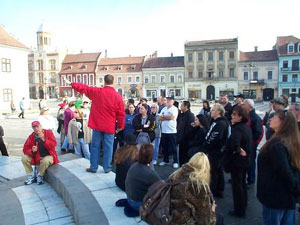 deformity that forced them to hide the child because of the shame it brought the family. One Easter, the child got free and came out, scaring (and scarring?) everyone in Sibiu. They thought it was a curse to create such a monster. Shelly adapted the legend into her story of 'Frankenstein.' We took many pictures of the Dracula and Frankenstein upstanding tombstones, and posed in the crypt's ancient wooden 'chair of chills.'
deformity that forced them to hide the child because of the shame it brought the family. One Easter, the child got free and came out, scaring (and scarring?) everyone in Sibiu. They thought it was a curse to create such a monster. Shelly adapted the legend into her story of 'Frankenstein.' We took many pictures of the Dracula and Frankenstein upstanding tombstones, and posed in the crypt's ancient wooden 'chair of chills.'The Iron Bridge is nicknamed the 'Liar's Bridge' after the tricky merchants who met here to trade, and the young lovers who declared their 'undying' love on it. We walked back to the coaches and set out south to reach Poienari Citadel.
We stopped along the way at an Orthodox monastery where inside the church we could see the paintings of the Dracul family on the left side as you faced the door to the street. Their clothing changed from Western to Eastern in style as they ruled all of the Orthodox World from Wallachia. The grandfather, uncle, and Vlad Draculia were all in that painting. Vlad Dracula's grandfather, Mircea the Old, was entombed here.
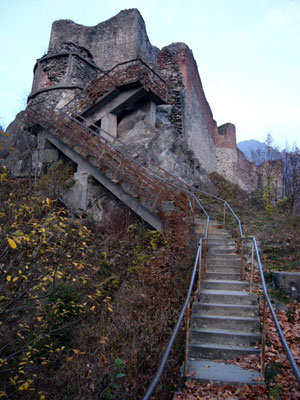
Continuing on, we reached the ruins of Poienari Citadel, Romania's true Dracula's castle. In 1459, Turks captured by Vlad Tepes in revenge for killing his father and brother marched along this route. At the end of the march, the Turks built the defensive fortress for the bloodthirsty prince. The result: a castle strategically positioned to guard the entrance from Transylvania into the Arges Valley. It was in this castle that Vlad imprisoned one of his wives. There are 1500 steps, which lead up from the side of a hydroelectric plant to the ruins.
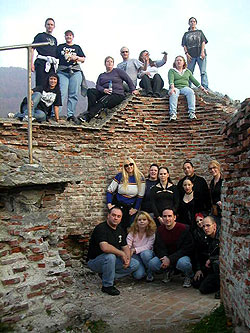
We had three hours to make the climb and take our photos before the bus had to leave. No one wanted to be up there when it got dark. Most of our tour group of 54 travelers made the ascent. Those who (for health reasons or otherwise) could not, spent the afternoon in a small town nearby shopping or eating. We were an exhausted but yet invigorated bunch as we headed back to Bucharest.
Arriving in the city where our journey had started, we found ourselves checking into the gothic Bulevard Hotel. A farewell dinner had been arranged for us at the nearby Club Dracula. A short walk down the side street from our hotel brought us to this theme restaurant. We were shown inside and it looked very much like a haunted hunting lodge in its decoration. Small tables of four or six dotted the rooms and with our large group we filled both upstairs and down below. Count Dracula made an appearance to brighten spirits and supply a great photo opportunity, not to mention nibbling a few necks along the way!. Inside, the atmosphere was enhanced with sound effects and fog. Small groups filtered back to the hotel or sought out further parties.
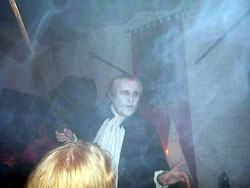
Some of the group arose early and took off down the street for one last chance to shop or explore the city. Frantically we searched for the last needed gifts or munchies for the flight and before we knew it, we boarded our bus for the airport.
Charles announced he would like to get a reunion of our group together for a haunted tour of England in 2006 and most of the group seemed to be very interested. Radu said goodbye as we left the buses, gathered our luggage for one last time and headed into the airport. The plane pulled away from Bucharest and we said goodbye to a land we had come to love. Reality stormed into our thoughts as we settled down to watch movies or sleep. They fed us well and we landed at Kennedy Airport in New York safe and sane and sound (well, two of three isn't bad).
We all longed for the adventures we had taken, but we have our email lists and our photos to keep the spirits alive and the warmth of newly made friends to tide us over as we return to our mundane lives. One of the greatest experiences of the trip was the way the group bonded. In just one short week, many lasting friendships were made from this extremely diverse group of people. The sense of camaraderie was incredible, and the group was just so much FUN! It appears that we have Vlad Dracula to thank for bringing us all together!
|
|
||

|
 |
|
Copyright © International Tours & Events LLC. All rights reserved







